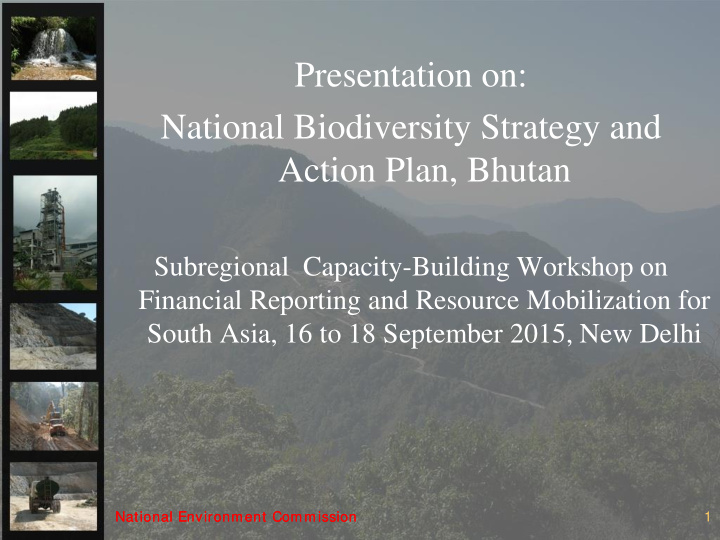



Presentation on: National Biodiversity Strategy and Action Plan, Bhutan Subregional Capacity-Building Workshop on Financial Reporting and Resource Mobilization for South Asia, 16 to 18 September 2015, New Delhi National Environment Commission National Environment Commission 1
Outline • background • Chapters • Annexes National Environment Commission National Environment Commission 2
NBSAP Bhutan • Background – The NBSAP was developed by taskforce members comprising of stakeholders – The document has five chapters – Stakeholder consultation conducted nationwide – Presentation to the policy makers – Submitted the NBSAP to the CBD Secretariat in October 2014 National Environment Commission 3
Chapter One • Review of past BAPs – The following are the major lessons learnt from the development and implementation of past BAPs: • The Action Plans provided a good reference on biodiversity and emerging issues, assisting institutions and individuals in preparing project proposals for funding • Lack of clear targets and indicators, including a monitoring and evaluation mechanism, made it difficult to assess progress • Lack of fund projections and a resource mobilization strategy led to poor implementation • Lack of a communication and outreach approach resulted in poor ownership and implementation by partners. • Relevant institutions established to support the implementation of actions were not delegated with rightful authorities and opportunities. • Lack of a national mechanism for coordination, fund mobilization and implementation resulted in poor implementation of past BAPs. National Environment Commission 4
• Chapter Two – Threats to biodiversity • Chapter Three – Issues and opportunities in biodiversity conservation and sustainable use • Chapter Four – National biodiversity strategies and action plan – National targets – 20 National Environment Commission 5
• Target 20: by 2016 the funding requirement for the implementation of the N BSAP identified and funds mobilized • Strategies and Actions – Strategy: Strengthen institutional mechanisms and good governance to coordinate fund mobilization for NBSAP implementation. – Action: Adopt the NBSAP as a guiding document for biodiversity management in the country. – Action : Establish the NBC as the national coordination agency for NBSAP implementation and resource mobilization. – Action : Establish a funding window for NBSAP implementation within BTFEC. National Environment Commission 6
– Strategy : Mobilize financial resources to support implementation of the NBSAP. • Action: Review the financial gap for implementation of the NBSAP. • Action : Develop and implement Resource Mobilization Plan. • Action : Allocate funds as per the Resource Mobilization Plan. • Action : Monitor effective and efficient utilization of available funds. • Chapter Five – NBSAP implementation plan – National coordinating structure – Resource mobilization approach National Environment Commission 7
National Environment Commission 8
Budget calculation • Ranking of targets • Basis – Five Year Plan budget allocation National Environment Commission 9
Assumptions: 1. Only financial support earmarked for biodiversity conservation has been reflected. For instance, support for Organic Farming, Field Crop Development Program, RNR Research and Extension Service, Rural Development Training, etc has not been accounted although it might have indirect contribution to biodiversity conservation. 2. The calculation of the financial allocation has been very loosely assessed. 3. It has been assumed that USD 3.37 million per annum includes secured financial support through Royal Government of Bhutan, Overseas Development Assistance and local donors. 4. Total indicative budget required until 2020 is USD 32,050,000 National Environment Commission 10
National Environment Commission 11
Tashi Delek National Environment Commission National Environment Commission 12
Recommend
More recommend